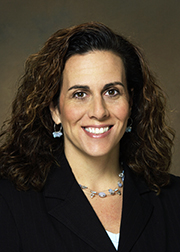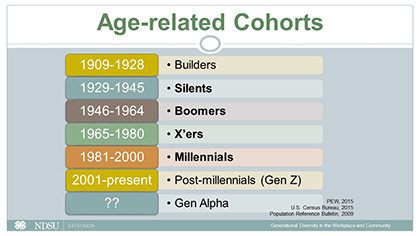Ask A Researcher
October 2018
Engaging Volunteers across Generations

Rachelle Vettern is an Associate Professor and the Leadership and Volunteer Development Specialist for North Dakota State University (NDSU) Extension. In her Extension role, she conducts research and provides education for youth and adults in the areas of leadership, ethics, generations, youth development, and volunteer development. She works with both the NDSU Extension Center for 4-H Youth Development and Family and Community Wellness. In her faculty role, she teaches online classes for the NDSU Great Plains interactive Distance Education Alliance (IDEA) Youth Development master’s program. She has her B.A. in Psychology and her M.S. in Counseling and Human Resource Development from South Dakota State University. Her Ph.D. is in Counselor Education and Supervision from North Dakota State University. In this article, Rachelle offers insight into engaging volunteers coming from a variety of generations, which resulted from a previous NDSU research study.
“Who is going to coach youth softball next summer? Who can we find to help with the community fall festival? How do we find volunteers for our faith community events, 4-H club, Scouts?” As community members, we have all heard these questions in our rural and urban areas across North Dakota. Volunteers are vital to any community, so what are the strategies we can use to encourage our North Dakota citizens to volunteer?
As a Generation Xer, I often had people who belonged to other generations ask me how to engage my age cohort in volunteer work. With that in mind, I set out with research partners, Drs. Thomas Hall and Mark Schmidt to answer the questions, “What motivates different generations to volunteer and are there generational differences that foster continued volunteerism?”
Merriam Webster defines a generation as, “a group of people born and living during the same time”. Currently we have six generations living and volunteering in our communities (see chart). There are multiple names for the generations, but our North Dakota research focused on the Builders/Silents, the Baby Boomers, the Generation Xers, and the Millennials. The Gen. Z’s or I-Gens, are now 18 years old, so further research needs to be conducted on their generations’ volunteering needs.

To answer these questions, we surveyed volunteers across North Dakota who were involved in a North Dakota State University (NDSU) Extension community leadership development program. What we discovered has informed our work and has led to the development of educational curriculum related to generational diversity and the delivery of many programs across that state focusing on this topic and engaging generations in the workplace and community. Here are some of the findings to inform those working with volunteers.
Motivation to Volunteer:
- Millennials are motivated by the opportunity to work with friends and give back to their community. They also like to volunteer for things that add to their resume and build their skills.
- Gen X is motivated by community involvement, by having the opportunity to volunteer with and for their children, and by working on addressing a meaningful cause.
- Baby Boomers are altruistic in their motivation. They like to work to address a community need and like to feel a sense of accomplishment.
- Silents/Builders like the sense of being needed by their volunteer organization, enjoy giving back to their community, and as a generation are following civic values instilled in them by their parents and grandparents.
Hindrance to Volunteering:
- As a generation, Millennials have a tendency to be overscheduled, so they may have time conflicts with the volunteer opportunity a group is offering. If volunteer experiences do not offer flexibility they may not attract this generation. They are also motivated by the individuals they will have a chance to volunteer with, so if there are personal conflicts with other volunteers, organizations will not retain this group.
- Xers also have challenges due to time constraints stemming from work and family commitments. As a generation, they have many volunteer prospects and state that they will not volunteer for an organization or group that contains people with negative attitudes towards others.
- Boomers express they, like the other generations, want flexibility in their volunteer experience. They are also turned off if the group they are volunteering with lacks organizational structure and vision. Finally, poor treatment of volunteers results in the Boomers leaving their volunteer positions quickly.
- The Silents/Builders too desire flexibility and will leave a volunteer experience that does not have clear objectives. They also report health challenges as hindering engagement in some volunteer experiences.
Motivation to Continue Volunteering (Retention):
- Millennials continue to volunteer if they enjoy the work and the people with whom they work. They stay engaged if they feel connected to the individuals or efforts for which they are helping/assisting.
- Xers like to continue to make a difference in the community in which they live and stay committed if they see marked results of these efforts. They enjoy being involved in their children’s activities and will stay engaged if they too like the people with whom they work.
- Boomers like to feel a sense of accomplishment and to feel needed and appreciated. They want confirmation by the volunteer organization that their talents and skills are unique and beneficial to the volunteer effort.
- Silents/Builders stress that they enjoy the social piece of volunteering. They continue to be engaged because they want to contribute to the survival of the volunteer organization and/or community. They also like to feel they are needed and seen as an asset to the effort.
Finding (recruiting) Volunteers:
- Millennials can often be found involved in young professionals’ groups and civic engagement clubs. They frequent fitness centers and coffee shops and can be recruited with social networking posts, through web sites, and via mass texts; but the most effective strategy is peer-to-peer recruitment. As one millennial stated in a generational volunteering workshop, “I’ll go if my friends are going. I have one friend who can talk me into volunteering for anything.”
- Gen. X can also be recruited through the strategies discussed above. Due to their current life stage, they, like millennials, can often be found at childcare centers, pediatricians’ offices, wellness centers, youth sporting and extracurricular events, and can be recruited through employer led volunteer events.
- Boomers can be engaged through high profile media and technology. They are often involved in business and civic organizations and can be recruited at wellness centers and health care facilities.
- Silents/Builders can be recruited through civic and social clubs, post career centers AKA “Centers for Active Generations”, health care facilities, and through faith communities.
- Overall, the most effective recruitment for all generations is the personal invitation either by a friend or the individual who is recruiting volunteers for that event or organization.
Recommendations to those who work with Volunteers across North Dakota:
Below are some suggestions for those who work with volunteers and want to engage individuals from multiple generations.
1. Demonstrate a need for volunteers and highlight numerous ways individuals can contribute.
2. Use multiple forms of communication to market volunteer opportunities: social media, web sites, radio, print media, and face-to-face.
3. Have role descriptions for each volunteer position. Volunteers today want to know what the expectations and commitments are related to the volunteer position.
4. Make volunteering a social affair and provide networking opportunities.
5. Manage volunteer events and the organization professionally.
6. Treat volunteers with respect, make them feel welcome, and avoid gossip and negativity at all costs. Be friendly to the new volunteers.
7. Offer numerous times or ways to volunteer to alleviate issues such as work and family conflicts.
8. Use your volunteers or you will lose your volunteers. When a volunteer shows up to work, provide a good orientation and put them to work. They are taking time out of their busy schedules to contribute to your organization, so make every minute count.
9. When working with multiple generations be conscientious of the language used. Do not refer to younger volunteers as “kids” or to older volunteers as “seniors”.
10. Let current volunteers know they are needed and have made a difference. Recognition is important!
11. Make the volunteer experience fun!
12. Celebrate successes and highlight the ways in which volunteers’ contributions have made a difference in your organization or community that would not have been possible without their help.
Overall keep in mind that different generations bring different strengths, beliefs, and attitudes to volunteering. Utilizing volunteers’ generational assets can have a positive impact on the climate, collegiality, and overall success of an organization. As we look across North Dakota for volunteers from multiple generations, it comes down to a quote from Dr. Susan Ellis, president of Energize, Inc., “Like so many other things in life, success as a recruiter of volunteers is highly dependent on attitude. If you can’t imagine that anyone will volunteer for you, they probably won’t. On the other hand, if you approach recruiting with a positive set of expectations, you will find that people will indeed join up.”
As noted above, as a result of this volunteer research, NDSU Extension developed a “Generational Diversity in the Workplace and Community” educational lesson. For more information on this or engaging volunteers from multiple generations, please email Rachelle Vettern or contact your local NDSU Extension office. Furthermore, if you wish to explore ways in which NDSU Extension is building leadership skills in volunteers to further engage North Dakota citizens civically, read Jodi Brun’s article, “NDSU Extension Takes Creative Approach to Enhancing Communities and Improving Leaders”.
You can find more information on the original volunteer research in the below journal articles:
• Vettern, R., Hall, T., and Schmidt, M. (2009). Understanding what rocks their world: Motivational factors of rural volunteers. Journal of Extension [On-line], 47(6), 1-9 Article FEA3.
• Hall, T., & Vettern, R. (2010). What makes them tick? Understanding our differences can enhance intergenerational volunteer collaboration. The International Journal of Volunteer Administration. XXVII(3).

References:
Carlson, E. (2009). 20th-century US generations. Population Bulletin, 64(1), 1-17. Retrieved from www.prb.org/pdf09/64.1generations/pdf
Colby, S. & Ortman, J. M. (2014). The Baby Boom cohort in the United States: 2012 to 2060. Current Population Reports, P25-1141. U.S. Census Bureau, Washington, DC.
Ferri-Reed, J. (2014). Millennializing the workplace. The Journal for Quality and Participation, 37(1), 13-14.
Fry, R. (2015). This year, Millennials will overtake Baby Boomers. Pew Internet and American Life Project. Retrieved from www.pewresearch.org/fact-tank/2015/01/16/
generation. (n.d.). In Merriam-Webster’s online dictionary (11th ed.). Retrieved from www.merriam-webster.com/ dictionary/generation
Hahn, J. A. (2011). Managing multiple generations: Scenarios from the workplace. Nursing Forum, 46(3), 119-127. doi:10.1111/j.1744-6198.2011.00223.x
Hall, T., & Vettern, R. (2010). What makes them tick? Understanding our differences can enhance intergenerational volunteer collaboration. The International Journal of Volunteer Administration. XXVII(3).
Hershatter, A., & Epstein, M. (2010). Millennials and the world of work: An organization and management perspective. Journal of Business and Psychology, 25(2), 211-223. doi:http://dx.doi.org/10.1007/s10869-010-9160-y
Knight, R. (2014). Generational issues: Managing people from 5 generations. Harvard Business Review. Retrieved from https://hbr.org/2014/09/managing-people-from-5-generations
Macon, M., & Artley, J. (2009). Can’t we all just get along? A review of the challenges and opportunities in a multigenerational workforce. International Journal of Business Research, 9(6), 90-94.
PEW. (2010). Millennials: A portrait of generation next. Pew Research Center’s Social & Demographic Trends. Retrieved from www.pewsocialtrends.org/files/2010/10/millennials-confident-connected-open- to-change.pdf
PEW. (2014). Millennials in adulthood: Detached from institutions, networked with friends. Pew Research Center’s Social & Demographic Trends. Retrieved from www.pewsocial trends.org/2014/03/07/millennials- in-adulthood/
Rasmussen, C. (2015). Leveraging generational differences in the workplace: Workforce solutions conference. University of Minnesota Extension.
Tokar, P. (2013). GEN busting. Economic Development Journal, 12(1), 41-46.
U.S. Census Bureau. (2015). Millennials outnumber Baby Boomers and are far more diverse, Census Bureau reports.
Vettern, R., Hall, T., and Schmidt, M. (2009). Understanding what rocks their world: Motivational factors of rural volunteers. Journal of Extension [On-line], 47(6), 1-9 Article FEA3.
